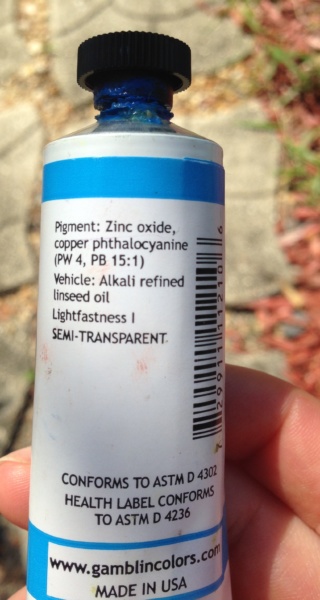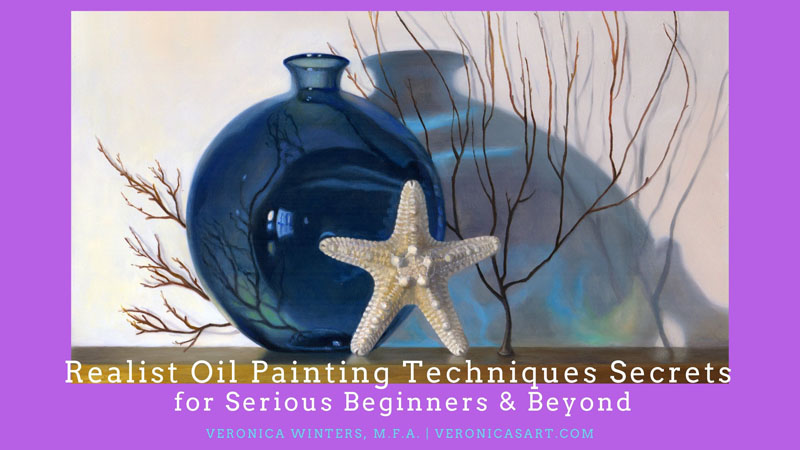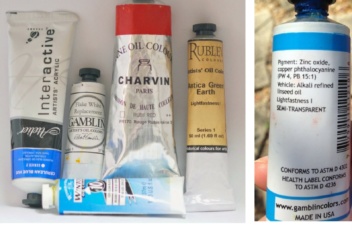While I’m not an expert in art conservation, I am a full-time artist. After years of painting, conversations with other professionals and some research, I can guide you in choosing your oil paints for your art. Feel free to research this topic further via my references at the bottom of this post or by contacting the products’ manufacturers. A lot of information listed here is coming from podcasts with the Natural Pigments’ director George O’Hanlon.
Picking the right brand of oil paint can be a challenge. Some brands are promoted so heavily by the art supply companies that artists buy their paints without having a second thought. When I was a student, the quality of paint hardly ever mattered to me and my most common determinant was the price. Today as I take care of my art my buying choices are strongly influenced by the overall quality and lightfastness of oil paint.
There are several important properties of oil paint artists should pay attention to. The most necessary information can be seen written right on a tube of paint. Don’t buy the paint that doesn’t have the following data printed on it.
1. Transparency vs. opaqueness of oil paint
While some oil colors are transparent, others are opaque or semi-opaque. If you see an empty square, or a half-empty one, or a filled square on the back cover of oil paint, it gives you information about the transparency of oil paint. Some brands just say “Transparent” or “Semi-opaque” as opposed to assigning a specific symbol to it. So when I chose my paint for glazing, applying the transparent layers of paint, I look at the square/ or a note on transparency to determine if my paint is naturally good for glazing. Some transparent colors are Gamblin’s ultramarine blue, Michael Harding’s bright yellow lake. The transparent colors look almost glass-like when mixed with linseed oil.
Opaque or semi-opaque colors are often good for scumbling, layering light opaque paint over the dark area.
2. Pigments used in oil paint determine the lightfastness (resistance to light) and longevity of your art.
This is the most important principle in choosing your paint. The pigments used in oil paint are described in letters and numbers. For example, PB15-phtylocianine blue is rated lightfastness I. PW1-lead white is lightfastness I. PR2-Napthol red G- lightfastness II, etc.
While some basic colors have just one pigment, there are many colors that consist of several pigments mixed together along with oil, fillers, and binders. These “new,” not historical colors give artists a lot more color choices, but every pigment present in such paint tube should be checked for lighfastness separately. For example, Winton flesh tint has 4 pigments in it (PW6, PW5, PY42, and PV19).
Here is extensive pigment information database that lists oil paint properties including the lightfastness of paints: http://www.artiscreation.com/

Each company performs its own tests. This information is written on the tube, and it reads either as +, ++ or +++, or lightfastness I, lightfastness II, or lightfastness III and so on. The higher the number (3-4) the less lightfast the paint is.
By nature, browns and ochres are often more lightfast than some funky colors, like alizarin crimson or turquoise. Those colors that have lightfastness 3-4 are fugitive and fade pretty quickly. If you paint professionally, those colors should be avoided.
Artists can perform their own tests by exposing 1/2 of paint to the sun (while the other half is covered by black tape or cardboard). Lift the tape in a month of continuous light exposure to see the change in color. Artist Virgil Elliott has tested numerous colors of various brands. You’ll find a lot of useful information on painting in his book Traditional oil painting and in his facebook group.
3. Type of oil mixed into the paint.
All tubed paints have some oil mixed into the paint. Linseed oil is the most stable oil that is also used widely as paint medium by artists. It’s long-lasting and dries quite quickly.
Safflower oil, poppy oil, and walnut oil are less stable oils often used as vehicles that are mixed into the oil paint. Avoid using safflower oil.
4. The amount of fillers and binders added to oil paint.
Various amounts of fillers and binders are mixed into the oils as well. They dilute the pigment by “stretching” the paint, making it cheaper to the consumer. Such pigments have a much longer shelf life. Fillers and binders greatly affect the consistency and texture of paint. It could affect the drying speed of paint as well.
Rublev colors, manufactured by Natural Pigments, don’t have any fillers in their paint, making the oils more stable and with high tinting strength. Like other professional-grade paints, they give artists a lot more pigment in a small tube as opposed to cheaper oil paint put in a large tube. But because NP have no extra binders, their shelf life is very limited and it’s best to use the paint within a year. I could barely squish the paint out of the tube after that.
Professional brands of oil paints include:
- Rublev colors by Natural Pigments
- Old Holland
- Michael Harding
- Gamblin
- Chroma
- Utrecht
- dardecor (Spain)
These are great resources for further research:
- The atelier movement– a closed group on Facebook-exists for artists interested in classical painting. The group’s administrator is classically trained artist-Graydon Parrish.
- Artist Virgil Elliot: http://virgilelliott.com/
- Douglas Flynt’ blog
- “The artist’s handbook of materials & techniques” by Ralph Mayer: http://www.amazon.com/The-Artists-Handbook-Materials-Techniques/dp/0670837016
- Sadie Valerie blog: http://www.sadievaleri.com/blog/
- The Natural Pigments website: https://www.naturalpigments.com/art-supply-education/painting-for-posterity-with-modern-oil-paints/

https://veronica-winters-art-school.teachable.com/p/realist-oil-painting-techniques-secrets-for-serious-beginners-beyond
